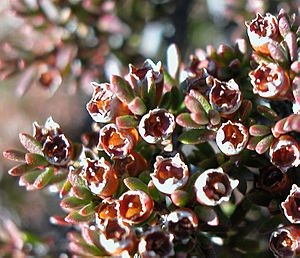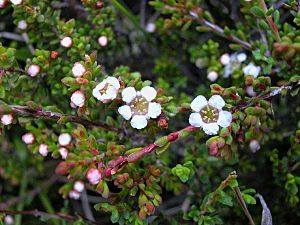Alpine baeckea facts for kids
Quick facts for kids Alpine baeckea |
|
|---|---|
 |
|
| Baeckea gunniana Photo © Greg Jordan. © 2019 University of Tasmania | |
| Conservation status | |
| Scientific classification | |
| Genus: |
Baeckea
|
| Species: |
gunniana
|
 |
|
| Occurrence distribution of Baeckea gunniana Atlas of Living Australia, Map data © OpenStreetMap, imagery © CartoDB | |
Baeckea gunniana, commonly known as alpine baeckea, is a small, bushy evergreen plant. It grows in the high mountain areas of Australia. Baeckea is a group of flowering plants in the myrtle family. There are 14 different Baeckea species, mostly found in eastern Australia and Asia.
Contents
What Does it Look Like?
Baeckea gunniana is a smooth, compact shrub. It usually grows up to 1.5 meters (about 5 feet) tall. In some lower areas, it can reach up to 2 meters (about 6.5 feet). Sometimes, it grows low and spreads out over rocks.
Its small branches are brown and have a papery bark. The leaves are tiny, only about 2 to 4 millimeters long. They are crowded together and shaped like a spoon, with a rounded tip.
Flowers and Fruit
The flowers are white, small, and grow in many places. They appear alone where the leaves meet the stem. Each flower is about 4 to 5 millimeters wide. They have small, round petals.
After the flowers, the plant produces fruit. When young, the fruit is green and cup-shaped. As it gets older, it becomes woody. Inside are tiny, angular seeds. These seeds are hard to see when they fall to the ground.
Sometimes, the seed coat can stop the seeds from growing. To help them sprout, people might gently scratch or nick the seed coat. This helps the seeds take in water and grow. You can also grow new B. gunniana plants from cuttings. This means taking a piece of a stem and planting it.
Where Does it Grow?
Baeckea gunniana only grows in alpine and subalpine regions. These are high mountain areas. You can find it from Mount Ginini in the Australian Capital Territory all the way to southwest Tasmania.
It grows best at high altitudes, usually between 1,000 to 1,400 meters (about 3,300 to 4,600 feet) high. However, it has been seen growing even higher, above 2,000 meters (about 6,500 feet) near Mount Kosciusko. It can also grow as low as 450 meters (about 1,500 feet) in western Tasmania.
Most Baeckea species are found only in Australia. But one type, B. frutescens, also grows from eastern Australia through Malesia (parts of Southeast Asia) to China.
Its Home
Baeckea gunniana often grows with other plants like Callistemon pityoides, Epacris paludosa, and Empodisma minus. It likes to grow in heathlands or boggy, wet areas. You can also find it near creeks. Sometimes, it grows in shady spots under Eucalyptus trees.
Who Named This Plant?
The plant was first officially described by a German botanist named Johannes Conrad Schauer. He did this in 1843.
How is it Used?
The leaves of Baeckea plants are safe to eat. People sometimes use them as a tea substitute. This is because they have a nice, citrus-like smell and taste.
B. gunniana is also important for the Broad-toothed mouse in New South Wales, Australia. It provides a safe home for these mice. The plant helps protect them from predators and other large animals that might graze in the area.



